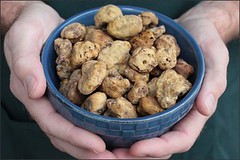A truffle (pronounced /ˈtrʌfəl/) is a fungi fruiting body that develops underground and are usually found in close association with trees.
The fruiting body of some truffles (mostly in the genus 'Tuber') are highly prized as a food. The 18th-century French gastronome Brillat-Savarin called these truffles "the diamond of the kitchen". Edible truffles are held in high esteem in French, Spanish, northern Italian and Greek cooking, as well as in international haute cuisine.
Growing symbiotically with oak, hazel, poplar and beech and fruiting in autumn, Italian white truffles are very highly esteemed (illustration, left). The white truffle market in Alba is busiest in the months of October and November, where a 1.6-pound white truffle sold to "The Cody" of southern California for $150,000 on November 8, 2009 during the 79th White Truffle Festival. In 2001, the Tuber magnatum truffles sold for between US$1,000 and $2,200 per pound.
The "black truffle" or "black Périgord truffle" is named after the Périgord region in France and grows exclusively with oak.
Looking for truffles in open ground is almost always carried out with specially trained pigs (truffle hogs) or, more recently, dogs.
White truffles are generally served raw, and shaved over steaming buttered pasta or salads. White or black paper-thin truffle slices may be inserted into meats, under the skins of roasted fowl, in foie gras preparations, in pâtés, or in stuffings. Some speciality cheeses contain truffles as well.
The flavour of black truffles is far less pungent and more refined than that of white truffles. It is reminiscent of fresh earth and mushrooms, and when fresh, their scent fills a room almost instantly.
In the last 30 years, new attempts for mass production of truffles have been started. Eighty percent of the truffles now produced in France come from specially planted truffle-fields.
Local farmers are opposed to a return of mass production, which would decrease the price of truffles. There are now truffle-growing areas in the United States, Spain, Sweden, New Zealand, Australia, Chile and the UK.
Tuesday, December 7, 2010
Subscribe to:
Post Comments (Atom)





No comments:
Post a Comment